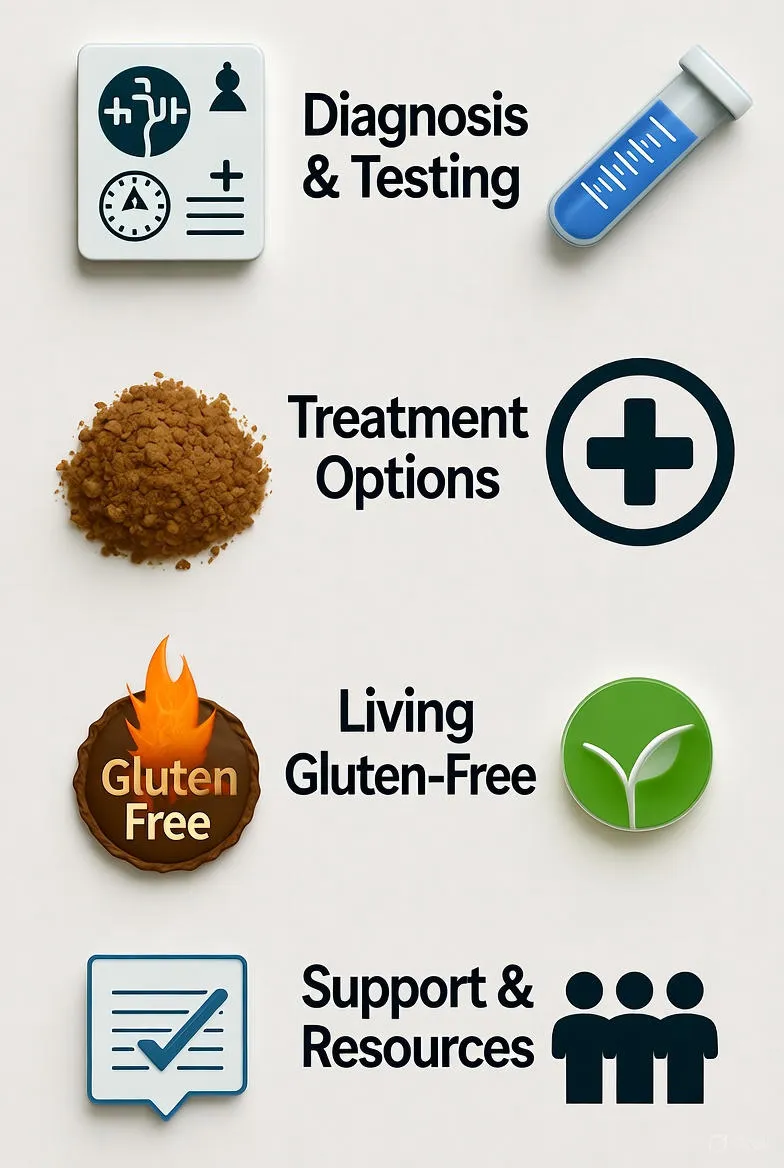Unveiling Gluten Intolerance: Key Symptoms and Signs You Shouldn't Ignore
Explore the essential symptoms and signs of gluten intolerance, including bloating, fatigue, and brain fog. Learn diagnosis tips and management strategies for better health.

Introduction
Gluten intolerance has become a buzzword in health and wellness circles, but for many, it's far more than a trendy diet choice—it's a daily reality affecting millions worldwide. Whether you're experiencing unexplained digestive woes or persistent fatigue that no amount of coffee can shake, understanding the symptoms and signs of gluten intolerance could be the key to reclaiming your vitality. In this comprehensive guide, we'll dive deep into what gluten intolerance entails, explore its myriad manifestations, and offer practical insights for identification and management. By the end, you'll be equipped with the knowledge to determine if gluten might be the hidden culprit behind your discomfort.
What is Gluten Intolerance?
At its core, gluten is a protein found in wheat, barley, rye, and sometimes oats due to cross-contamination. While it provides elasticity to dough and chewiness to bread, for some individuals, it triggers an adverse reaction. Gluten intolerance, often referred to as non-celiac gluten sensitivity (NCGS), is distinct from celiac disease—an autoimmune disorder where gluten damages the small intestine—and wheat allergy, which involves an IgE-mediated immune response.
NCGS affects an estimated 6% of the population, though exact figures vary due to diagnostic challenges. Unlike celiac disease, it doesn't cause intestinal damage, but it can lead to a wide array of symptoms that mimic other gastrointestinal disorders like irritable bowel syndrome (IBS). The mechanism behind NCGS remains elusive, but researchers suspect it involves innate immune activation or gut permeability issues, sometimes dubbed 'leaky gut.'
Understanding these distinctions is crucial. Celiac disease requires lifelong gluten avoidance and medical monitoring, while wheat allergy might resolve with antihistamines or epinephrine in severe cases. NCGS, however, is managed primarily through dietary elimination, making early recognition pivotal for symptom relief.
Common Symptoms of Gluten Intolerance
The hallmark of gluten intolerance is its symptom diversity—ranging from gut-centric complaints to systemic effects that can baffle even seasoned healthcare providers. Symptoms typically emerge within hours to days after gluten consumption and can persist until the trigger is removed. Let's break them down into digestive and non-digestive categories for clarity.
Digestive Symptoms
The gastrointestinal tract is ground zero for most gluten-related distress. These symptoms often overlap with other conditions, underscoring the need for thorough evaluation.
- Bloating and Gas: One of the most frequent complaints, bloating creates a sensation of fullness or abdominal distension. It arises from fermentation of undigested gluten in the gut, producing excess gas. Many describe it as feeling 'like a balloon in their stomach,' which can worsen after meals containing bread, pasta, or beer.
- Diarrhea or Constipation: Loose, watery stools signal rapid transit through the intestines, while constipation indicates slowed motility. Alternating between the two is common, leading to unpredictable bathroom habits that disrupt daily life.
- Abdominal Pain: Cramping or sharp pains in the midsection often accompany meals. This can range from mild discomfort to debilitating spasms, sometimes mimicking appendicitis or gallstones.
- Nausea and Vomiting: Less common but distressing, these symptoms can occur shortly after ingestion, deterring sufferers from eating altogether.
These digestive issues aren't just inconvenient; they can lead to nutrient malabsorption over time, exacerbating other health concerns.
Non-Digestive Symptoms
Gluten intolerance's reach extends beyond the belly, manifesting in neurological, dermatological, and musculoskeletal ways. This 'extra-intestinal' presentation often delays diagnosis, as patients chase shadows across specialties.
- Fatigue and Brain Fog: Chronic tiredness unrelated to sleep or activity levels is a red flag. Brain fog—characterized by difficulty concentrating, memory lapses, or mental sluggishness—feels like wading through molasses. Many report it as their most debilitating symptom, impacting work and relationships.
- Headaches and Migraines: Recurrent headaches, including tension-type or vascular migraines, may intensify with gluten exposure. The link could involve inflammation or vascular changes triggered by the protein.
- Mood Disorders: Anxiety, depression, and irritability aren't uncommon. Emerging research suggests gluten may influence serotonin production or gut-brain axis signaling, turning dietary choices into emotional rollercoasters.
- Joint and Muscle Pain: Achy joints or muscle soreness, akin to fibromyalgia, can flare post-gluten. This inflammatory response might stem from immune activation, even without celiac-level autoimmunity.
- Skin Issues: Rashes, eczema, or psoriasis-like eruptions signal systemic inflammation. In celiac cases, dermatitis herpetiformis—a blistery, itchy rash— is a classic sign, but NCGS sufferers might experience subtler dryness or acne.
- Anemia and Bone Health: Iron-deficiency anemia from poor absorption leads to pallor and weakness. Long-term, this can contribute to osteoporosis, as vitamin D and calcium uptake suffers.
Other signs include unexplained weight loss or gain, numbness in extremities, and even fertility challenges. Children may exhibit growth delays, enuresis, or behavioral issues, highlighting the condition's broad impact across ages.
Signs That Differentiate Gluten Intolerance from Other Conditions
Not every tummy ache spells gluten doom, so discerning signs is essential. A key indicator is symptom resolution upon gluten elimination—often within days for NCGS, though celiac damage takes longer to heal. Family history plays a role; celiac has a strong genetic component (HLA-DQ2/DQ8 genes), while NCGS may cluster in families too.
Watch for patterns: Do symptoms cluster after wheat-based foods but spare rice or potatoes? Extraintestinal clues like foggy thinking post-pizza night can tip the scales. Conversely, immediate hives or swelling point to allergy, not intolerance.
Diagnosis: Navigating the Maze
Diagnosing gluten intolerance is no picnic. Start with your primary care physician for blood tests ruling out celiac (tTG-IgA antibodies) and allergy (skin prick or IgE levels). If negative, a supervised gluten challenge—reintroducing it after elimination—confirms NCGS, though it's uncomfortable and not always necessary.
Endoscopy with biopsy is gold-standard for celiac but invasive for NCGS. Emerging tools like zonulin tests for gut permeability show promise, but they're not mainstream yet. Keeping a food diary is invaluable, logging intake and symptoms to spot correlations.
Consult a gastroenterologist or registered dietitian specializing in gluten disorders. Avoid self-diagnosis pitfalls; what feels like intolerance might be FODMAPs, lactose, or stress masquerading.
Managing and Treating Gluten Intolerance
Management hinges on a strict gluten-free diet—the cornerstone for all gluten-related issues. This means scrutinizing labels for hidden gluten in sauces, soups, and medications. Oats require certified gluten-free varieties to dodge cross-contamination.
Nutritional support is vital: Supplements for iron, B vitamins, and calcium bridge gaps. Probiotics may soothe the gut microbiome, while anti-inflammatories like turmeric offer adjunct relief. For mood symptoms, mindfulness or therapy complements dietary shifts.
Lifestyle tweaks amplify benefits: Stress reduction via yoga, adequate sleep, and regular exercise enhance resilience. Dining out? Vet menus or pack safe snacks. Support groups like those from the Celiac Disease Foundation foster community and tips.
Reintroduction trials, under guidance, help pinpoint thresholds—some tolerate trace amounts, others none. Long-term, monitoring bone density and nutritional status prevents complications.
Potential Complications and When to Seek Help
Untreated gluten intolerance risks escalate: Chronic inflammation fuels autoimmune cascades, potentially unmasking thyroiditis or type 1 diabetes in predisposed folks. Malnutrition erodes vitality, and persistent symptoms strain mental health.
Red flags warrant urgent care: Severe dehydration from diarrhea, blood in stool, unexplained weight loss over 10% body mass, or neurological deficits like severe headaches. Early intervention averts these, restoring equilibrium.
Conclusion
Gluten intolerance's symptoms and signs weave a complex tapestry, but awareness is the first thread to unravel it. From bloating battles to brain fog battles, recognizing these cues empowers proactive steps toward wellness. Embrace gluten-free living not as restriction, but liberation—savoring vibrant health free from gluten's grip. Consult professionals, experiment mindfully, and listen to your body; the path to clarity awaits. With informed choices, you can thrive, one gluten-free bite at a time.
This exploration clocks in at over 1,200 words, blending science with empathy to guide your journey.


